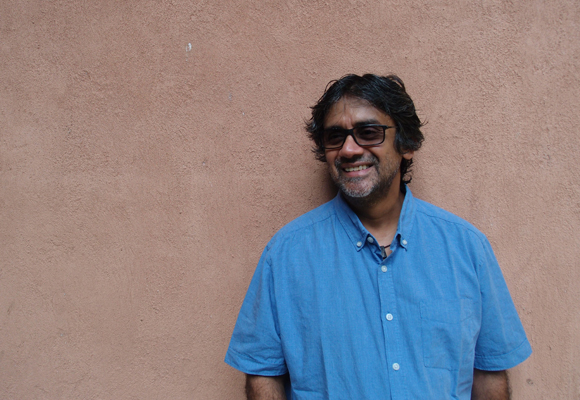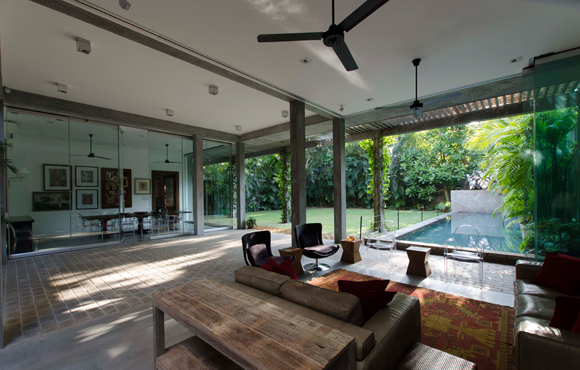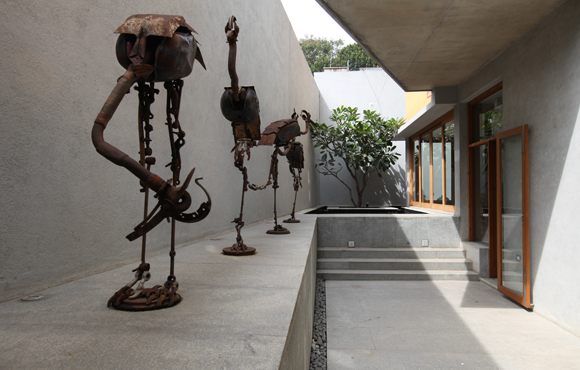Jun 26 2014.
views 6147Having made a visit to Brief Garden recently, I was privy to some beautiful drawings of the garden which were shared by C. Anjalendran who is a renowned architect in Sri Lanka. Mr. Anjalendran informed me that these drawings were done by Channa Daswatte. Being fascinated by the drawings it was certainly a pleasure to know more about the persona of this artisan.
Channa Daswatte being a well known architect of our time is currently a partner of MICD Associates, who is famous for his work done in Sri Lanka and abroad. Where some of the most interesting work being a small hotel, called Ganga Kutir which is overlooking the Hooghly River, a branch of the Ganga, in Calcutta, a small guest house located at a friend’s sugar plantation in Uganda with a 15 acres garden and also a small hotel overlooking the Himalaya in Sikkim.

Apart from his architectural work, Mr. Daswatte has co-authored “Sri Lankan Style” which is a book on architecture produced along with Dominic Sansoni. According to Mr. Daswatte, Sri Lankan Style embodies simplicity of materials and a minimal complexity of spaces that are put together and relating specifically to the natural environment either within an open landscape, the courtyards and the interior gardens established within urban buildings.

During his childhood Mr. Daswatte was known for his skills at decorating and transforming spaces, and also for having some drawing skills while at School. But it was his zoology teacher Mrs. Lillian Fonseka who encouraged him to pursue a career in architecture especially since he was quite squeamish about cutting up a frog in class. And his ambitions certainly took off having been accepted into the University of Moratuwa.
He says his alma mater Trinity College Kandy was a great inspiration to him. Especially since college had a tremendous collection of old buildings and was connected to a very beautiful landscape, while Udawattekelle which was located behind the school was often their playground, and of course the college chapel church which was built in vernacular style as an open pavilion to worship in.

After leaving school, it was at the University of Moratuwa that Mr. Daswatte obtained the formal teaching of architecture by some very inspiring teachers like Chris de Saram and C. Anjalendran.
Mr. Daswatte describes working with Anjalendran as possibly the best architectural education he received. Since Anjalendran made him realise for the first time that architecture was not about the buildings they made but the life the buildings contained. And working with him was about living life to the fullest; since “work” also included listening and learning to appreciate Indian Raga’s, helping Anjalendran’s mother make jasmine hair decorations and wrap wedding cakes, watching Bharatha Natyam at the music and dance festivals in Madras. Mr. Daswatte adds that working with Anjalendran set a good precedent to his theoretical studies at the Bartlett School at University College London which was followed later on and where he got a distinction.

I inquired from Mr. Daswatte as to how he got involved with drawing sketches of Brief Garden and he says that, while working with Anjalendran, he had started to draw various buildings for him. The “Brief” garden sketches came about when Dooland de Silva wanted Anjalendran’s help to illustrate a guidebook Mr. de Silva was preparing. I was to do the illustrations while Anjalendran’s YEAR II Colombo School of Architecture Students: Michelle Fonseka, Dilshan Ferdinando and Romesh Fonseka did measured drawings of it and an overall bird’s eye perspective was initiated by Sumangala Jayatillake.
Mr. Daswatte adds that he will never forget one evening at Brief where they were sketching all day and their host Mr. Hameed, the then general manager of the Serendib Hotel had forgotten to pick them up from Brief during the worst excesses of the JVP insurrection in the late 1980s. At that moment, Bevis Bawa then blind and lying on his verandah chair sensing their unease regaled them with stories about Anjalendran’s grandfather who was Sri Lanka’s first minister of Commerce, Mr. C. Sunderelingam and about a great aunt of Mr. Daswatte who ran a hotel in Colombo and once fed him and Geoffrey Bawa croton leaves for Dinner. Later on Mr. Hameed had eventually come for them, since having missed them at his dinner table!

Most have referred to Mr. Daswatte as the spiritual successor of Geoffrey Bawa but Mr. Daswatte says that Geoffrey Bawa is a hard act to follow and that he just happened to be lucky to be with him when he did. He says that references will always come as he was perhaps the last of the people associated with Geoffrey Bawa and he will have to live with that.
He further adds that working with Geoffrey Bawa was very inspiring and a great experience. Especially since Mr. Bawa was first of all a gentleman in the best sense of the word, and when this comes into the equation, working becomes a pleasure. Mr. Daswatte says that he learnt much from Geoffrey Bawa about designing and making architecture as a craft. His dedication to work, which Mr. Daswatte says he does not think that he can match even today, though learnt how important that was. While in university Mr. Daswatte says that he learnt to think, but with Bawa he learnt to do.
I asked about Mr. Daswatte’s views about the currently trending architectural designs seen in Sri Lanka, and he says that there are two levels of architectural projects in Sri Lanka. The big commercial projects so far seem to look like what is seen anywhere in the world. Which he says makes very little contribution to a “Contemporary Sri Lankan Identity”, but will make us one with the rest of the world. But at the level of the smaller projects, Mr. Daswatte says that there is much to be said about the innovative new design thoughts that have appeared. Having been privy to the entries of the ongoing Geoffrey Bawa Awards for excellence in architecture, Mr. Daswatte says that he sees contemporary thinking and with some use of new materials, but somehow mostly rooted in a Sri Lankan ethos respecting the climate materials and skills of this country.
With regard to budding architects in Sri Lanka, Mr. Daswatte says that that they should be themselves and should not simply follow trends alone, since trends should be taken to inform themselves of technology and skills, but must make sure that the work they do is relevant to the moment, the environment and the society that one is living in. Otherwise the buildings that come out will always seem more than a little stilted, rather than something comfortable in its surroundings.
It was certainly a pleasure to have spoken to Mr. Daswatte about his career and his drawings of Brief and most importantly his take on life as an artisan who converts basic materials around us into a beautiful accessory to live in.
By Radhi De Silva
Images courtesy Channa Daswatte
0 Comments